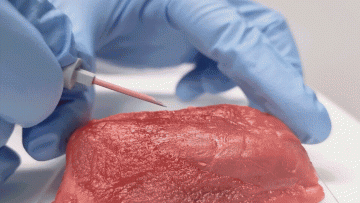KAIST
BREAKTHROUGHS
Research Webzine of the KAIST College of Engineering since 2014
Spring 2024 Vol. 22An intravenous needle that irreversibly softens upon insertion by body temperature

The softening IV needle can soften by body temperature upon insertion, deform and freely follow the motion of the peripheral vein without the risk of mechanical damage. Throughout its use, the needle remains entirely soft, preventing accidental needlestick injury and reuse.
Medical IV needles are manufactured using hard materials such as stainless steel or plastic, which do not mechanically match the softness of the biological tissues of the body. This can cause severe problems in healthcare settings, leading to tissue damage and inflammation at the injection site. The current structure of rigid medical IV devices also enables unethical reuse of needles that can lead to detrimental transmission of deadly viral infections such as HIV and hepatitis B/C. In addition, accidental needlestick injuries are recurring incidents in medical settings around the world. These are potential causes of such infections, with IV needles carrying the greatest risk of spreading these infectious diseases.
To address these concerns, Professor Jae-Woong Jeong and his research team in the School of Electrical Engineering at KAIST have developed an IV needle that softens upon insertion, which can improve a patient’s well-being. In addition, biocompatibility studies were conducted in a joint study led by Professor Won-Il Jeong of the Graduate School of Medical Sciences.
The new IV needle can allow more mobility among patients without worrying about pain at the injection site because it can reduce the risk of damage to thin-walled veins as patients receive IV medication (Figure 1). This is possible due to the softening effect of the needle. When the needle is inserted into the body, the temperature of the body makes the needle soft and flexible, allowing the needle to adjust its shape to the movement of the thin-walled vein. Moreover, the softening IV needle has the potential to prevent transmission of deadly viral infections caused by accidental needlestick injuries or unethical re-use of needles, as the softened needle remains entirely soft even after it is removed from the injection site.

The biocompatibility of the softening IV needle was validated through animal studies. Results of in vivo studies in mice showed that implanted needles caused significantly less inflammation relative to the standard IV access devices of similar size made of metal needles or plastic catheters.
Researchers also showed the possibility of on-site temperature monitoring by integrating a customized ultra-thin temperature sensor with the softening IV needle. Adding the sensor can further enhance the patient’s well-being, either by monitoring the core body temperature or detecting undesired fluid leakage on-site during indwelling use.
The transformative IV needle can facilitate a wide range of opportunities, particularly in clinical setups in instances of redesigning other medical needles or sharp medical tools to reduce muscle tissue injury during indwelling use.
The results of this work was published in Nature Biomedical Engineering on October 30, 2023, under the title, “A temperature-responsive intravenous needle that irreversibly softens on insertion” (Nat. Biomed. Eng (2023). https://doi.org/10.1038/s41551-023-01116-z)
Most Popular

An intravenous needle that irreversibly softens upon insertion by body temperature
Read more
Consistent visual editing of complex visual modalities: videos and 3D scenes
Read more
SUPPORT enables accurate optical readout of voltage signals in neurons
Read more
AI for detecting aimbots in FPS games
Read more
Origami-based deployable space shelter
Read more